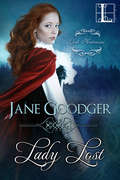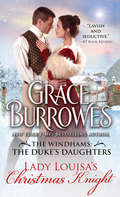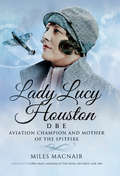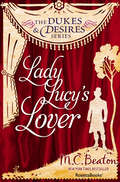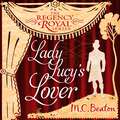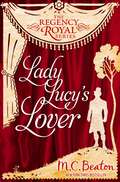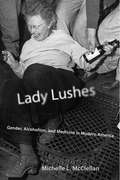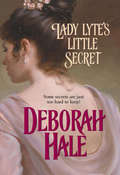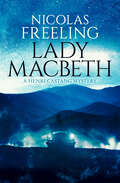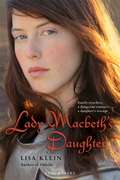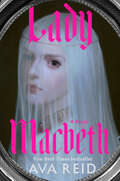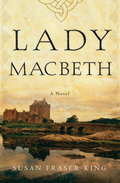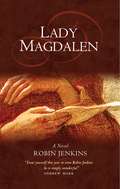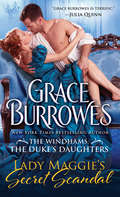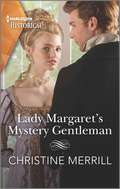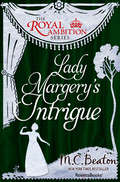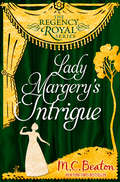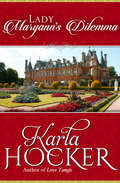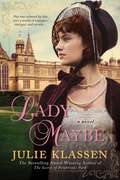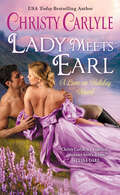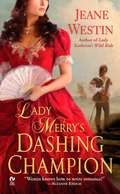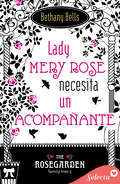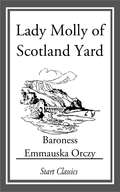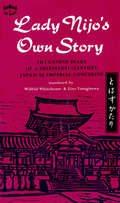- Table View
- List View
Lady Lost (Lost Heiresses #3)
by Jane GoodgerA captivating Victorian romance of a betrayed man, a ruined woman, and an unexpected chance at happiness from the author of How to Please a Lady.All Marcus Granton wants is to be left alone to lick his wounds after the humiliating scandal of his wife&’s death in another man&’s bed. Secluded in his moldering seaside estate on the cliffs of the North Sea, he suddenly finds himself host to Lady Lilian Martin, one small child, and an annoying cache of servants all bent on ruining his solitude. Seems the lady got herself into a bit of a pickle and is accused of murder, of all things. Now she must rely on him for protection—and to keep his thoughts and hands away from her delectable body.Lilian has no intention of spending any more time with the insufferable Lord Marcus Granton than she has to. But at every turn, circumstances force her into his company, and by the time she&’s ready to make her escape, it&’s far too late for her . . . and her heart.Praise for the writing of Jane Goodger &“Fun, delightfully romantic—and sexy.&” —Sally MacKenzie, USA Today–bestselling author&“A touching, compassionate, passion-filled romance.&” —RT Book Reviews &“Gentle humor, witty banter, and attractive characters.&” —Library Journal
Lady Louisa's Christmas Knight (Windham Series #6)
by Grace Burrowes'Tis the Season for Scandal...Years ago Lady Louisa Windham acted rashly on a dare from her brother, and that indiscretion is about to come to light. She knows her reputation will never survive exposure. Just as she's nearly overwhelmed by her dilemma, Sir Joseph Carrington offers himself to her as a solution...But Sir Joseph has secrets as well, and as he and Louisa become entangled with each other, their deceptions begin to close in on them both...Windham series:The Heir (Book 1) The Soldier (Book 2)The Virtuoso (Book 3)Lady Sophie's Christmas Wish (Book 4) Lady Maggie's Secret Scandal (Book 5)Lady Louisa's Christmas Knight (Book 6) Lady Eve's Indiscretion (Book 7)Lady Jenny's Christmas Portrait (Book 8)Praise for RITA-nominated Lady Sophie's Christmas Wish:"An extraordinary, precious, unforgettable holiday story."—RT Book Reviews, 4½ stars, Top Pick of the Month, Best Historical Romance, RT Book Reviews 2011 Reviewers' Choice Awards"My Christmas wish for you is that Santa brings you this book...a joyful sensual read."—USA Today Happy Ever After"Supremely sexy, emotionally involving, and graced with well-written dialogue...a fascinating, enjoyable read."—Library Journal"Burrowes continues to write outside the usual Regency box with strong characters and humor similar to Amanda Quick's."—Booklist
Lady Lucy Houston DBE: Aviation Champion and Mother of the Spitfire
by Miles MacnairThe life-story of Lady Lucy Houston DBE must surely be one of the most romantic and dramatic epics of the last one hundred and fifty years, yet nowadays she is a woman unknown. She was a renowned beauty with a sharp intelligence, and over the years she would exploit her charismatic charm, first as a teenager to entice a wealthy lover, and subsequently to lead three husbands to the altar.She was an ardent and productive campaigner for womens rights, conducting outstanding works of charity during the Great War, such as providing a convalescent home for nurses returning from the front line. In recognition of these endeavours, she was made a Dame of the British Empire in 1917. After the death of her third husband, a known misogynist, under mysterious circumstances, she was temporarily certified mad, but his Will was to make her the richest woman in England. During the rest of her eventful and eccentric lifetime, she spent her fortune on a vast number of charitable causes, whilst waging a feisty political campaign against weak British politicians of all parties. As a great admirer of how Mussolini had restored Italys patriotic self-esteem, she championed men like Winston Churchill as the future saviour of her own beloved country. But her greatest legacy arose from her steadfast support for the Royal Air Force, whose finances were being crippled. She funded the 1931 Schneider Trophy Race as well as the Houston-Mount Everest Expedition of 1933. This funding had a crucial bearing on the development of the Merlin engine and the Spitfire aircraft, essentially kick starting the chain of events that would ultimately end in allied victory during the Battle of Britain. She died before the cataclysmic war that she so accurately predicted however, her death being precipitated by an infatuation with Edward, Prince of Wales.In spite of her many eccentricities, the enchanting, infuriating, inspiring and endlessly controversial Lucy Houston deserves to be remembered as a very patriotic lady indeed.
Lady Lucy's Lover (The Dukes and Desires Series #6)
by M. C. BeatonHeaven comes to a marriage made in hell in this Regency romance from the New York Times–bestselling author of the Hamish Macbeth mysteries.Poor Lucy was living a dream—a bad one. One could even say a nightmare. She had married a gambler, a womanizer, and a drunkard. And she refused to admit that his frequent overnight absences were of any significance. The sting came when it was revealed that Lucy’s parents had “bought” her husband for her. And then one night at a ball, Lucy met the charismatic Duke of Habard and suddenly anything seemed possible . . . Praise for M.C. Beaton “A romance writer who deftly blends humor and adventure . . . [sustaining] her devoted audience to the last gasp.” —Booklist“Veteran author Marion Chesney (aka M.C. Beaton) delivers top-notch Regency fare.” —RT Book Reviews
Lady Lucy's Lover: Regency Royal 8 (Regency Royal)
by M. C. BeatonPoor Lucy was living a dream. She had married a gambler, a womanizer, and a drunkard. And she refused to admit that his frequent overnight absences were of any significance. <p><p>The sting came when it was revealed that Lucy's parents had bought her husband for her. And then one night at a ball, Lucy met the charismatic Duke of Habard and suddenly anything seemed possible.
Lady Lucy's Lover: Regency Royal 8 (Regency Royal)
by M.C. BeatonPoor Lucy was living a dream. She had married a gambler, a womanizer, and a drunkard. And she refused to admit that his frequent overnight absences were of any significance.The sting came when it was revealed that Lucy's parents had bought her husband for her. And then one night at a ball, Lucy met the charismatic Duke of Habard and suddenly anything seemed possible.
Lady Lushes: Gender, Alcoholism, and Medicine in Modern America
by Michelle L. McClellanAccording to the popular press in the mid twentieth century, American women, in a misguided attempt to act like men in work and leisure, were drinking more. “Lady Lushes” were becoming a widespread social phenomenon. From the glamorous hard-drinking flapper of the 1920s to the disgraced and alcoholic wife and mother played by Lee Remick in the 1962 film “Days of Wine and Roses,” alcohol consumption by American women has been seen as both a prerogative and as a threat to health, happiness, and the social order. In Lady Lushes, medical historian Michelle L. McClellan traces the story of the female alcoholic from the late-nineteenth through the twentieth century. She draws on a range of sources to demonstrate the persistence of the belief that alcohol use is antithetical to an idealized feminine role, particularly one that glorifies motherhood. Lady Lushes offers a fresh perspective on the importance of gender role ideology in the formation of medical knowledge and authority.
Lady Lyte's Little Secret
by Deborah HaleFelicity Lyte Was In a QuandaryHow could she tell her cherished paramour of his impending fatherhood? Hawthorn Greenwood, despite his straitened circumstances, would surely make a responsible, honorable offer of mariage-which Felicity could never accept. For she would only wed him in truebound love-or not at all!Thorn Greenwood had thought to but share an idyllic Season with Lady Lyte-and instead found his soul's partner. But Felicity had abruptly ended their liaison. Did she think him a fortune hunter? A rank falsehood that, for the only wealth he sought was the bounty of her love!
Lady Macbeth (The Henri Castang Mysteries)
by Nicolas FreelingRenowned French Detective Castang investigates a missing wife and her suspicious husband in this mystery from an Edgar award–winning British crime writer.Guy and Sibille Lebfevre had what most people would call a normal marriage—until they have an argument while on a road trip through the Vosges mountains. Enraged, Sibille gets out of the car, disappearing on the otherwise deserted road, never to be heard from again.Six months later, Guy has not even bothered to look for his wife. When Inspector Castang questions him, Guy claims his wife is too proud to come home. This does not sit right with Castang or anyone close to Sibille, as they all suspect her husband of murdering her. But as Castang soon realizes, no one really knows what happens—or doesn’t happen—between a husband and wife. . . . Praise for Nicolas Freeling:“In depth of characterization, command of language and breadth of thought, Mr. Freeling has few peers when it comes to the international policier.” —The New York Times“Nicolas Freeling . . . liberated the detective story from page-turning puzzler into a critique of society and an investigation of character.” —The Daily Telegraph“Freeling rewards with his oblique, subtly comic style.” —Publishers Weekly“Freeling writes like no one. . . . He is one of the most literate and idiosyncratic of crime writers.” —Los Angeles Times
Lady Macbeth's Daughter
by Lisa KleinRaised by three strange sisters, Albia has never known the secrets of her parentage. But when Macbeth seeks out the weird sisters to foretell his fate, his life is entangled with his unknown daughter's. When Albia foresees the terrible future, she becomes determined to save Macbeth's rival--and the man she loves--from her murderous father. Klein's seamlessly drawn tale makes it seem impossible that Albia was not part of Shakespeare's original play.
Lady Macbeth: A Novel
by Ava ReidFrom #1 New York Times bestselling author Ava Reid comes a &“masterful reimagining&” (Publishers Weekly) of Lady Macbeth, Shakespeare&’s most famous villainess, giving her a voice, a past, and a power that transforms the story men have written for her.&“Lady Macbeth doesn&’t retell Shakespeare so much as slice cleanly through it, revealing what was hidden beneath. I couldn't look away.&”—Alix E. Harrow, New York Times bestselling author of Starling House The Lady knows the stories: how her eyes induce madness in men. The Lady knows she will be wed to the Scottish brute, who does not leave his warrior ways behind when he comes to the marriage bed. The Lady knows his hostile, suspicious court will be a game of strategy, requiring all of her wiles and hidden witchcraft to survive. But the Lady does not know her husband has occult secrets of his own. She does not know that prophecy girds him like armor. She does not know that her magic is greater and more dangerous, and that it will threaten the order of the world. She does not know this yet. But she will.
Lady Macbeth: A Novel
by Susan Fraser KingI am granddaughter to a king and daughter to a prince, a wife twice over, a queen as well. I have fought with sword and bow, and struggled fierce to bear my babes into this world. I have loved deeply and hated deeply, too. Lady Gruadh, called Rue, is the last female descendent of Scotland's most royal line. Married to a powerful northern lord, she is widowed while still carrying his child and forced to marry her husband's murderer: a rising war-lord named Macbeth. Encountering danger from Vikings, Saxons, and treacherous Scottish lords, Rue begins to respect the man she once despised-and then realizes that Macbeth's complex ambitions extend beyond the borders of the vast northern region. Among the powerful warlords and their steel-games, only Macbeth can unite Scotland-and his wife's royal blood is the key to his ultimate success. Determined to protect her small son and a proud legacy of warrior kings and strong women, Rue invokes the ancient wisdom and secret practices of her female ancestors as she strives to hold her own in a warrior society. Finally, side by side as the last Celtic king and queen of Scotland, she and Macbeth must face the gathering storm brought on by their combined destiny. From towering crags to misted moors and formidable fortresses, Lady Macbeth transports readers to the heart of eleventh-century Scotland, painting a bold, vivid portrait of a woman much maligned by history. From the Hardcover edition.
Lady Magdalen
by Robin JenkinsThis beautifully rendered novel of 17th century Scotland imagines the life of Lady Magdalene, 1st Marchioness of Montrose, during the English Civil War. Magadalen, the fourteen-year-old daughter of Lord Carnegie of Kinnaird, shares with her childhood friend, Francis Gowrie of Mintlaw, a love of art and beauty, and a horror of barbaric practices such as the burning of women thought to be witches. But, with civil war brewing and family alliances paramount, Carnegie arranges her marriage to an ambitious young soldier, James Graham, Earl of Montrose. So begins this captivating portrait of the little-known wife of the infamous Scottish nobleman. In Lady Magdalen, Robin Jenkins casts his ironic and informed eye over war-torn 17th-century Scotland, juxtaposing the feminine and domestic with the political and military ramifications of the era. It is a lush and acutely perceptive tale by an author whose &“deeply ambivalent analysis of human idealism has established him as the greatest living fiction writer in Scotland&” (The Scotsman, UK).
Lady Maggie's Secret Scandal (Windham Series #5)
by Grace BurrowesA USA Today Bestseller!"Delicious…Burrowes delivers red-hot chemistry with a masterful mix of playfulness and sensuality."—Publishers Weekly, STARRED ReviewMaggie Windham leads a dignified life... until stolen letters bring her to investigator Benjamin Hazlit's door. When it becomes clear Maggie is being blackmailed, Benjamin becomes determined to find not just the letters, but the way to Maggie's heart.And she's been perfectly capable of keeping them...until now. When she's threatened with exposure, she turns to investigator Benjamin Hazlit to keep catastrophe at bay. But Maggie herself intrigues Benjamin more than the riddle she's set him to solve. As he uncovers more and more of her past, Maggie struggles to keep him at a distance, until they both begin to discover the truth in their hearts...Windham series:The Heir (Book 1) The Soldier (Book 2)The Virtuoso (Book 3)Lady Sophie's Christmas Wish (Book 4) Lady Maggie's Secret Scandal (Book 5)Lady Louisa's Christmas Knight (Book 6) Lady Eve's Indiscretion (Book 7)Lady Jenny's Christmas Portrait (Book 8)Praise for The Soldier:"Captivating...Burrowes's straightforward, sensual love story is intelligent and tender, rising above the crowd with deft dialogue and delightful characters."—Publishers Weekly, Starred Review"There is a quiet, yet intense power to Burrowes's simple prose and such depth of feelings that it will be difficult to forget this marvelous story."—RT Book Reviews 4 ½ Stars, Top Pick of the Month"Burrowes continues her winning streak with a delicious, sensual historical romance capturing the spirit of the time."—Booklist"With lots of humor and steamy romance, these books are always a delightful read, a treat for fans of Regency romance at its best."—Night Owl Romance
Lady Margaret's Mystery Gentleman (Secrets of the Duke's Family #1)
by Christine MerrillClose quartersWill reveal hidden truths…Desperately hoping for a season to escape her overprotective brother, Lady Margaret convinces him to hire her a dancing master. David Castell is dashing, exciting and mysterious, yet his probing questions about her family raise Margaret’s suspicions… And she discovers that her charming teacher is undercover investigating her brother for murder! Margaret’s determined to prove David wrong, but their irresistible attraction is disrupting both their plans…From Harlequin Historical: Your romantic escape to the past.Secrets of the Duke’s FamilyThe mysteries and passions of the aristocracy!Book 1: Lady Margaret’s Mystery Gentleman
Lady Margery's Intrigue (The Royal Ambition Series #6)
by M. C. BeatonTo save her home, a woman must risk her heart in this fun Regency romance from the New York Times–bestselling author of the Traveling Matchmaker series. At age twenty-three, the petite Lady Margery has already graced the rows of wallflowers for many a season. With the one exception of Charles, the Marquess of Edgecombe, the only man who ever dances with her, Lady Margery will have nothing to do with men. What&’s more, she does not even particularly like Charles. Bored beyond words, she returns to the comfort of her only love: her home at Chelmswood. But even there, she still cannot find the respite she seeks. It seems her middle-aged father has taken for himself a dim-witted brat of nineteen to be his bride. Forced into bankruptcy by his child-bride&’s lust for luxury, Margery&’s father determines to sell Chelmswood. But Margery will not hear of it and launches an all-out, military-like campaign to ensnare a wealthy husband and save her ancestral family home. Everything seems to be going according to plan until the unforeseen intervention of Charles sabotages Margery&’s plan, giving them both a run for their money.
Lady Margery's Intrigue: Regency Royal 4 (Regency Royal)
by M.C. BeatonAt age twenty-three, the petite Lady Margery has already graced the rows of wallflowers for many a season. With the one exception of Charles, the Marquess of Edgecombe, the only man who ever dances with her, Lady Margery will have nothing to do with men; what's more, she does not even particularly like Charles.Bored beyond words, she firmly decides this to be the end of it all and returns to the comfort of her only love, her home at Chelmswood. But she does not find comfort, not even there. It seems her middle-aged father has taken for himself a dim-witted brat of nineteen to be his bride.Forced into bankruptcy by his child-bride's lust for luxury, Margery's father determines to sell Chelmswood. But Margery will not hear of it and launches an all-out, military-like campaign to ensnare herself a wealthy husband and save her ancestral family home.Everything seems to be going according to plan until the unforeseen intervention of Charles sabotages Margery's plan, giving them both a run for their money.
Lady Maryann's Dilemma (Regency Romance Ser.)
by Karla HockerA fiancé deceit leads a practical lady to embrace her true passion in this Regency romance by the author of The Devilish Marquis. Having never seen a love match that didn&’t end in disaster, Lady Maryann Rivington is determined to wed for practical reasons. So the last thing she wants to hear is a slanderous accusation against her carefully-chosen betrothed. She can't imagine why the handsome stranger who approached her in the Botanic Gardens is so intent on preventing her marriage. But she is so befuddled by the passion in his eyes that she no longer feels rational in the least. Major Stephen Fant spent months gathering evidence against the man who had destroyed his brother, and now the scoundrel is finally within his reach. Though he knows it could jeopardize everything, he simply has to warn his quarry's beautiful fiancée that her betrothed is under investigation. After all, Lady Maryann is far too delectable for the likes of the lowly Lord Tammadge. And as the major gazes into her wide gray eyes, he realizes he'd do anything to keep her safe—except stay away.
Lady Maybe
by Julie KlassenIn the new novel by the three-time Christy Award-winning author of The Maid of Fairbourne Hall, a woman's startling secrets lead her into unexpected danger and romance in Regency England... One final cry..."God almighty, help us!" and suddenly her world shifted violently, until a blinding collision scattered her mind and shook her bones. Then, the pain. The freezing water. And as all sensation drifted away, a hand reached for hers, before all faded into darkness...Now she has awakened as though from some strange, suffocating dream in a warm and welcoming room she has never seen before, and tended to by kind, unfamiliar faces. But not all has been swept away. She recalls fragments of the accident. She remembers a baby. And a ring on her finger reminds her of a lie.But most of all, there is a secret. And in this house of strangers she can trust no one but herself to keep it.
Lady Meets Earl: A Love on Holiday Novel (Love on Holiday #2)
by Christy CarlyleUSA Today bestselling author Christy Carlyle sweeps readers away on an all-new romantic holiday to the wilds of Scotland where a young woman discovers her vacation home is unexpectedly owned by a strange, devastatingly handsome earl.After a lifetime of living for her friends, family, even strangers, Lady Lucy Westmont knows something must change or she’ll lose herself forever. An invitation to visit her free-spirited and scandalous aunt in the wild Scottish countryside is the perfect opportunity to discover how to live the life she wants.James Pembroke just learned that not only is he the new Earl of Rossbury, he’s also inherited his late uncle’s debts and a manor house deep in Scotland. Already owing money to an unsavory man because of a business deal that went awry, he has no choice but to travel to Scotland to sell the manor. On his way, he finds himself sharing a train car with a rather pretty but wild young woman.When Lucy manages to make it to her aunt’s home, she discovers her aunt is missing and the incredibly rude man who shared her train car is claiming that he owns the house instead. Nevertheless, Lucy is determined to have a true holiday, even if she is accompanied by the man who has upended her plans—and her heart.
Lady Merry's Dashing Champion
by Jeane WestinIt seems Meriel-called Merry-looks exactly like the wife of Lord Giles, Earl of Warborough, whose legendary heroism has long sent a thrill down Merry's spine. Giles's cold, unfaithful wife is known to be a spy for the Dutch. Coerced by the British king's spymaster, Merry takes the traitor's place as a double-agent-with the aim of delivering false intelligence to the waiting Dutch. But Merry's dangerous mission only fans the flames of her smoldering desire for Giles-even as Giles is overtaken by passion for a "wife" who's suddenly become all he ever wanted.
Lady Mery Rose busca un acompañante (The Rosegarden Family Tree #Volumen 5)
by Bethany Bells¿Acaso puede el amor ser evitado por la cláusula de un contrato? A diferencia de su hermana mayor, lady Mary Rose Rosegarden -que odia su nombre, su apellido, y las rosas en general- no quiere ni maridos ni amantes, ni montar escándalos como los que lady Roseanne ha vivido. Pero, como resulta extraño que en su segunda temporada siga sin establecer un compromiso, y sus abuelos presionan de un modo insoportable para que lo haga, resuelve seguir en eso la costumbre familiar y busca una solución, como poco, excéntrica.Así, decide contratar un acompañante por horas, de entre los amigos de sus hermanos, siempre tan endeudados. Alguien que simule ser un pretendiente a cambio de dinero, que la corteje a ojos de todo Londres, pero que tenga muy claro que jamás habrá nada entre ellos. Lo mejor quehace lord Charles Cherry en la vida es maldecirse a sí mismo. Pero ¿cómo no hacerlo, si es incapaz de ganar una sola mano de cartas en un mundo donde los caballeros poco más pueden hacer? A esas alturas casi le ha quedado claro que es un hombre de mucha suerte. Eso sí, de la mala. Aunque, en definitiva, también debe contar con una pizca de la otra, de la mejor de las fortunas, porque, justo cuando empezaba a temerse el visitar la cárcel por deudas, la hermosa Mary Rose le ha hecho una propuesta imposible de rechazar. De lo que no está tan seguro, es de si podrá cumplir todas sus condiciones y no enamorarse de ella.
Lady Molly of Scotland Yard
by Emmauska OrczyFrom the author of 'The Scarlet Pimpernell', comes a series of 12 stories featuring one of literature's first female detectives. Molly Robertson-Kirk a.k.a. Lady Molly shares the same mental prowess as C. Auguste Dupin and Sherlock Holmes but brings a woman's wit to the table making for a formidable crime buster. Join her as she solves the crimes that plague the hills and highlands of Inverness, Scotland.
Lady Nijo's Own Story
by Eizo Yanagisawa Wilfrid WhitehouseAs a historical work, the book documents the routine of long-ago court life, with its great emphasis on poetry contests, "football" games, drinking parties, and clothing (at the most tragic moment, Lady Nijo stops to describe what the messenger bringing word of her lover's death is wearing).Lady Nijo's story is much more than a day-to-day record of trivial events. It is the tale of a courageous woman, told with consummate skill. Scholoars agree that the newly-discovered diary is one of the masterpieces of the country's literature, a genuine autobiography that not only records the social pastimes of the aristocracy, but also gives a contemporary view of the political and economic movements of the time.
Lady Nijo's Own Story
by Eizo Yanagisawa Wilfrid WhitehouseAs a historical work, the book documents the routine of long-ago court life, with its great emphasis on poetry contests, "football" games, drinking parties, and clothing (at the most tragic moment, Lady Nijo stops to describe what the messenger bringing word of her lover's death is wearing).Lady Nijo's story is much more than a day-to-day record of trivial events. It is the tale of a courageous woman, told with consummate skill. Scholoars agree that the newly-discovered diary is one of the masterpieces of the country's literature, a genuine autobiography that not only records the social pastimes of the aristocracy, but also gives a contemporary view of the political and economic movements of the time.
